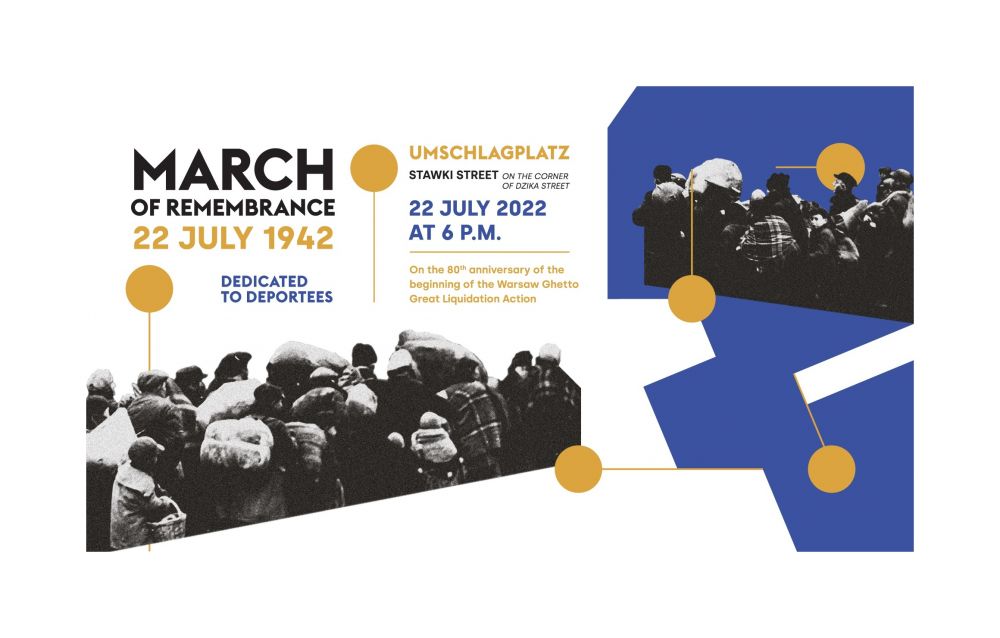- News
- Events
- Oneg Shabbat
- Collections
- Research
- Exhibitions
- Education
- Publishing Department
- Genealogy
- About the Institute
- Bookstore


It’s been 80 years since the Nazi Germans began the so-called “Grossaktion Warschau” – a huge deportation of Jews to the extermination camp in Treblinka. From July 22 to September 21, 1942, from Umschlagplatz – the square at Stawki Street from which transportations to the gas chambers took place – as well as on the overcrowded trains going to the camp, and in Treblinka itself, nearly 300,000 Jews were murdered.
We invite you to take part in the March of Remembrance, 22 July 1942. As every year, we will pay tribute to the victims of the great deportation. We will remember, in a special way, the Jewish refugees and deportees from cities and towns in occupied Poland and Europe, who died in the Warsaw Ghetto due to hunger and disease, or were killed in Treblinka in the summer of 1942.
Warsaw, 1940-1941, gate at the Żelazna Street/Leszno Street intersection. Jews displaced from towns near Warsaw are waiting to enter the ghetto. Photo by unknown author, JHI collection
Warsaw ghetto wall on Bonifraterska Street, 1940-1942. Photo by unknown author, Ringelblum Archive, JHI collection
Warsaw ghetto, Leszno Street, June 1941. Photo by Willy Georg, JHI collection
Every fourth person in the “Jewish district” was forcibly displaced from cities and towns such as Łódź, Płock, Sochaczew, Sierpc, Góra Kalwaria, Piaseczno, as well as from Berlin and Hamburg. The refugees lived in the worst conditions and were the first to be sent to Treblinka.
The March will start on July 22 at 6.00 p.m. at the Umschlagplatz Memorial in Warsaw (10 Stawki Street, on the corner of Dzika Street) and will follow the symbolic route ‘from death to life’, which will end at Stare Nalewki Street – this is where the center of Jewish Warsaw was located before the war.
The March will conclude with a concert prepared by the cellist and arranger Michał Pepol in collaboration with Sława Przybylska, a legend of the Polish music scene. As every year, the participants of the March will carry symbolic Ribbons of Remembrance with the names of murdered Jewish deportees and refugees. On Stare Nalewki Street an open-air exhibition devoted to their memory, designed by Jan Strumiłło, will be on display until 1st September. We have planned accompanying events around the installation – details will be provided soon.
_____
2022 marks the 80th anniversary of the beginning of “Operation Reinhardt”, a plan of genocide of Polish Jews, prepared and carried out by Nazi Germany. Until the end of the operation in November 1943, the Germans murdered nearly 2 million Jews from the General Government, the Białystok region, and other European countries: Czech Republic, Slovakia, Greece, former Yugoslavia, as well as Germany and Austria.
The main extermination camps were Bełżec, Sobibór, Treblinka, and Majdanek, where people were murdered with gas. Thousands of Jews were also shot in the streets of the ghettos and died of lack of water and air during transportation. As a result of “Operation Reinhardt”, most of the large Jewish communities in occupied Poland ceased to exist.
_____
March of Remembrance, 22 July 1942 – beginning on 22 July 2022, 6:00 pm CET
Organizer: the Emanuel Ringelblum Jewish Historical Institute
Route: Umschlagplatz Memorial – Stawki Street – Andersa Street – along Krasiński Garden – Stare Nalewki Street
Volunteers will give out the ribbons containing names of murdered Jews.
![2022_Marsz_Pamięci_mapa.jpg [198.37 KB]](https://www.jhi.pl/storage/image/core_files/2022/7/12/413939477300a51ee431cb54a42d4570/jpg/jhi/preview/2022_Marsz_Pamięci_mapa.jpg)
Honorary Patronage:
Commemoration of the 80th anniversary of the extermination of Jews as part of the German Operation "Reinhardt" is under the Honorary Patronage of President of the Republic of Poland Andrzej Duda
The March of Remembrance is under the Honorary Patronage of the President of the Capital City of Of Warsaw
Partners:
Taube Center
Forum for Dialogue
Hillel Warsaw
The Mazovia Institute of Culture
Warsaw Ghetto Museum
Socio-Cultural Society of Jews in Poland
Media Partners:
Jet Line
Polskie Radio Program II
Rzeczpospolita
Ströer
TVP Kultura
Wirtualna Polska
Financing:
The project entitled "Organization of the events March of Remembrance and commemoration of the Holocaust in Treblinka" co-financed by the Minister of Culture and National Heritage
The project is financed by Iceland, Liechtenstein and Norway from the EEA Grants and the Polish Ministry of Culture and National Heritage
_____
What was the great deportation?
On July 22, 1942, began the so-called liquidation action of the Warsaw Ghetto. According to German announcements, the Jews were to be "relocated to the East". Every day 3,000 to 8,000 people were deported to Treblinka from the Umschlagplatz in Warsaw; 300,000 Jews were led this way during the 46 days of the "operation".
Only a handful of those led onto the trains managed to jump out and saved themselves. Few refugees from Treblinka returned to Warsaw and provided information about gas chambers, but this did not stop the deportation. Jews were murdered not only by gas, many died from lack of air while being transported in overcrowded cattle cars.
A few months later, on April 19, 1943, in the face of the inevitable extermination, the Jews decided to fight for honor and a dignified death, arms in hand. After almost a month of fighting, the uprising was suppressed by the German occupant, and Warsaw was recognized as a city "judenfrei" – free of Jews. Since 2012, the Emanuel Ringelblum Jewish Historical Institute organizes the March of Remembrance on the anniversary of these tragic events, commemorating the largest Jewish community in pre-war Europe.